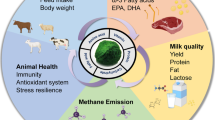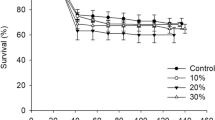Summary
What digestive adaptations permit herbivorous nonruminant mammals to sustain much higher metabolic rates than herbivorous lizards, despite gross similarity in digestive anatomy and physiology? We approached this question by comparing four herbivorous species eating the same diet of alfalfa pellets: two lizards (chuckwalla and desert iugana) and two mammals (desert woodrat and laboratory mouse). The mammals had longer small and large intestines, greater intestinal surface area, much higher (by an order of magnitude) food intake normalized to metabolic live mass, and much faster food passage times (a few hours instead of a few days). Among both reptiles and mammals, passage times increase with body size and are longer for herbivores than for carnivores. The herbivorous lizards, despite these much slower passage times, had slightly lower apparent digestive efficiencies than the mammals. At least for chuckwallas, this difference from mammals was not due to differences in body temperature regime. Comparisons of chuckwallas and woodrats in their assimilation of various dietary components showed that the woodrat's main advantage lay in greater assimilation of the dietary fiber fraction. Woodrats achieved greater fiber digestion despite shorter residence time, but possibly because of a larger fermentation chamber, coprophagy, and/or different conditions for microbial fermentation. We conclude with a comparative overview of digestive function in herbivorous lizards and mammals, and with a list of four major unsolved questions.
Similar content being viewed by others
References
Asplund JM, Harris LE (1970) A technique and apparatus for the study of rate of passage of feed residues through the digestive tract of sheep. J Anim Sci 31:1199–1204
Batzli GO, Cole FR (1979) Nutritional ecology of microtine rodents: digestibility of forage. J Mammal 60:740–750
Bleavins MR, Aulerich RJ (1981) Feed consumption and food passage time in mink (Mustela vison) and European ferrets (Mustela putorius furo). Lab Anim Sci 31:268–269
Bjorndal KA (1979) Cellulose digestion and volatile fatty acid production in the green turtle,Chelonia mydas. Comp Biochem Physiol 63A:127–133
Clemens ET (1980) The digestive tract: insectivore, prosimian, and advanced primate. In: Schmidt-Nielsen K, Bolis L, Taylor CR (eds) Comparative physiology: primitive mammals. Cambridge University Press, Cambridge, pp 90–99
Clemens ET, Maloiy GMO (1981) Organic acid concentrations and digesta movement in the gastrointestinal tract of the bushbaby (Galago crassicaudatus) and Vervet monkey (Cercopithecidae pygerythrus). J Zool 193:487–497
Clemens ET, Phillips B (1980) Organic production and digesta movement in the gastrointestinal tract of the baboon and Sykes monkey. Comp Biochem Physiol 66A:529–532
Diamond JM, Karasov WH (1984) Effect of dietary carbohydrate on monosaccharide uptake by mouse small intestine in vitro. J Physiol 349:419–440
Greenwald OE, Kanter ME (1979) The effects of temperature and behavioral thermoregulation on digestive efficiency and rate in corn snakes (Elaphe guttata guttata). Physiol Zool 52:398–408
Grodzinski W, Wunder BA (1975) Ecological energetics of small mammals. In: Golley FB, Petrueswicz K, Ryskowski L (eds.) Small mammals: their productivity and population dynamics. Cambridge University Press, Cambridge, pp 173–204
Guard CL (1980) The reptilian digestive system: general characteristics. In: Schmidt-Nielsen K, Bolis L, Taylor CR (eds) Comparative physiology: primitive mammals. Cambridge University Press, Cambridge, pp 43–51
Hamilton WJ Jr (1944) The biology of the little short tailed shrewCryptotis parva. J Mammal 25:1–7
Harlow HJ (1981) Effect of fasting on rate of food passage and assimilation efficiency in badgers. J Mammal 62:173–177
Harlow HJ, Hillman SJ, Hoffman M (1976) The effect of temperature on digestive efficiency in the herbivorous lizard,Dipsosaurus dorsalis. J Comp Physiol 111:1–6
Harwood RH (1979) The effect of temperature on the digestive efficiency of three species of lizards,Cnemidophorus tigris, Gerrhonotus multicarinatus andSceloporus occidentalis. Comp Biochem Physiol 63A:417–433
Iverson JB (1982) Adaptations to herbivory in iguanine lizards. In: Burghardt GM, Rand AS (ed) Iguanas of the world. Their behavior, ecology and conservation. Noyes Publications, Park Ridge, pp 60–76
Karasov WH (1982) Energy assimilation, nitrogen requirement, and diet in free-living antelope ground squirrelsAmmospermophilus leucurus. Physiol Zool 55:378–392
Karasov WH, Solberg DH, Diamond JM (1985a) What transport adaptations enable mammals to absorb sugars and amino acids faster than reptiles? Am J Physiol 249:G271–283
Karasov WH, Buddington RK, Diamond JM, (1985b) Adaptation of intestinal sugar and amino acid transport in vertebrate evolution. In: Gilles R, Gilles-Baillien MG (ed) Transport processes, iono-, osmoregulation. Springer, Berlin Heidelberg New York Tokyo, pp 227–239
Karasov WH, Diamond JM (1983) Adaptive regulation of sugar and amino acid transport by vertebrate intestine. Am J Physiol 245:G443-G462
Karasov WH, Pond RS, Solberg DH, Diamond JM (1983) Regulation of proline and glucose transport in mouse intestine by dietary substrate levels. Proc Natl Acad Sci USA 80:7674–7677
Keys JE Jr., Van Soest PJ (1970) Digestibility of forages by the meadow vole (Microtus pennsylvanicus). J Dairy Sci 53:1502–1508
Kostelecka-Myrcha A, Myrcha A (1964) The rate of passage of foodstuffs through the alimentary tracts of certainMicrotidae under laboratory conditions. Acta Theriol 9:37–52
Lee C, Horvath DJ (1968) Management of meadow vole (Microtus pennsylvanicus). J Anim Sci 27:1517 (Abstract)
McBee RH (1970) Metabolic contributions of the cecal flora. Am J Clin Nutr 23:1514–1518
McBee RH, McBee VH (1982) The hindgut fermentation in the green iguana,Iguana iguana. In: Burghardt GM, Rand AS (ed) Iguanas of the world. Their behavior, ecology and conservation. Noyes Publications, Park Ridge, pp 77–83
Nagy KA (1975) Nitrogen requirement and its relation to dietary water and potassium content in the lizardSauromalus obesus. J Comp Physiol 104:49–58
Nagy KA (1977) Cellulose digestion and nutrient assimilation inSauromalus obesus, a plant-eating lizard. Copeia 1977:355–362
Parra R (1978) Comparison of foregut and hindgut fermentation in herbivores. In: Montogemry GG (ed) The ecology of arboreal folivores. Smithsonian Institution Press, Washington, D.C., pp 205–229
Pough FH (1973) Lizard energetics and diet. Ecology 54:837–844
Robbins CT (1983) Wildlife feeding and nutrition. Academic Press, New York
Ruppert RM (1980) Comparative assimilation efficiencies of two lizards. Comp Biochem Physiol 67A:491–496
Short HL (1961) Food habits of a captive least weasel. J Mammal 42:273–274
Sibley RM (1983) Strategies of digestion and defecation. In: Townsend CR, Calow P (eds) Physiological ecology: an evolutionary approach to resource use. Sinauer Associates, Inc., Sunderland Massachusetts, pp 109–142
Skoczylas R (1970) Influence of temperature on gastric digestion in the grass snake,Natrix natrix L. Comp Biochem Physiol 35:885–903
Stevens CE (1977) Comparative physiology of the digestive system. In: Swenson MJ (ed) Duke's physiology of domestic animals, 9th edn. Cornell University Press Ithaca New York, pp 216–232
Stevens CE (1980) The gastrointestinal tract of mammals: major variations. In: Schmidt-Nielsen K, Bolis L, Taylor CR (eds) Comparative physiology: primitive mammals. Cambridge University Press, Cambridge, pp 52–62
Troyer K (1984a) Structure and function of the digestive tract of a herbivorous lizardIguana iguana. Physiol Zool 57: 1–8
Troyer K (1984b) Diet selection and digestion inIguana iguana: the importance of age and nutrient requirements. Oecologia 61:201–207
Uden P, Van Soest PJ (1982) Comparison of digestion of timothy (Phleum pratense) fiber by ruminants, equines and rabbits. Br J Nutr 47:267–272
Van Soest P (1982) Nutritional ecology of the ruminant. O and B Books Corvallis, Oregon
Author information
Authors and Affiliations
Rights and permissions
About this article
Cite this article
Karasov, W.H., Petrossian, E., Rosenberg, L. et al. How do food passage rate and assimilation differ between herbivorous lizards and nonruminant mammals?. J Comp Physiol B 156, 599–609 (1986). https://doi.org/10.1007/BF00691047
Accepted:
Issue Date:
DOI: https://doi.org/10.1007/BF00691047




